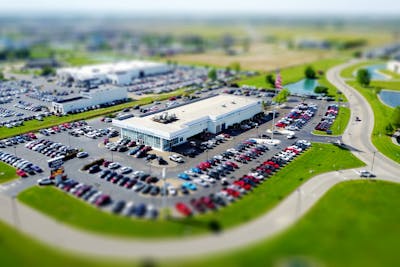How to Run a Used Car Dealership: 8 Expert Tips for Long-Term Success


If you’re considering how to run a used car dealership, you are on the path to a potentially profitable business. A used car dealership offers a wide range of opportunities for success, but it also comes with unique challenges. From selecting the right inventory to understanding market trends, there are many factors to consider when running a used car lot business.
This guide will walk you through the essential steps to make sure your used car dealer business thrives in a competitive market.
Table of Contents
Step 1: Market Research and Business Planning
The foundation of any successful used car sale business is thorough market research. Before you open your dealership, you need to understand the local market, what types of vehicles are in demand, and what prices customers are willing to pay. Knowing the market trends will help you decide the types of cars to focus on for your used car dealership.
Once you’ve gathered this information, the next step is to create a comprehensive business plan. This plan should cover all aspects of your used car dealer business, including target customers, inventory strategies, marketing tactics, and financial projections.
Key Components of Your Business Plan:
- Target Market: Define the demographic you’re aiming for (e.g., economy buyers, luxury buyers).
- Sales Strategy: Outline how you will sell and promote your vehicles.
- Operational Plan: How will you source your cars? What will be your pricing model?
- Financial Projections: Plan your budget, costs, and expected profits.
Step 2: Legal Requirements and Licensing
In order to run a used car sale business, you must comply with legal regulations, which include obtaining a dealer’s license, registering your business, and getting insurance. Each state or region has specific requirements, so it’s crucial to research what applies to your location.
Steps to Get Licensed:
- Dealer’s License: You must obtain a dealer’s license from your state’s Department of Motor Vehicles (DMV). The process may require you to pass a background check and provide proof of financial stability.
- Business Registration: Register your used car dealership with the local government and choose a business structure, such as an LLC or sole proprietorship.
- Insurance: Get adequate business insurance to protect your dealership, as well as surety bond insurance, which is required for most dealerships.
Step 3: Sourcing Inventory for Your Used Car Dealership
One of the most important aspects of running a used car dealer business is maintaining a high-quality inventory. Your reputation depends on the vehicles you sell, so sourcing reliable cars is critical. You can acquire vehicles through a variety of channels:
- Auctions: Car auctions can be a great source for affordable vehicles, though you need to thoroughly inspect each car.
- Trade-ins: Offering customers the ability to trade in their old vehicles can add to your inventory while boosting sales.
- Private Sellers: Buying from individual owners can give you access to well-maintained cars at lower prices.
Make sure you have a solid process for inspecting and reconditioning each vehicle before putting it on the lot.
Step 4: Setting Up Your Used Car Dealership Location
The location of your used car lot business plays a crucial role in attracting customers. Look for a highly visible location with plenty of space to display your inventory. Ensure that your lot is clean, well-organized, and inviting to customers.
Location Essentials:
- Showroom or Office Space: A professional space where you can meet and negotiate with potential buyers.
- Service Area: If you plan to offer repairs or maintenance, you’ll need a service department.
- Signage: Clearly mark your used car dealership with professional signage to increase visibility.
Step 5: Marketing Your Used Car Dealership
A strong marketing strategy is essential for getting your used car sale business off the ground. Today’s consumers rely heavily on online research when buying used cars, so it’s important to invest in both digital and traditional marketing strategies.
Digital Marketing:
- Website: Create a professional website for your dealership, where you can list your inventory, share customer testimonials, and provide contact details. Optimize it for search engines with keywords like “used car dealer business” and “used car sale business” to attract local traffic.
- Social Media: Use platforms like Facebook and Instagram to promote your inventory and connect with potential buyers.
- SEO (Search Engine Optimization): Target local keywords like “used car dealer near me” to improve your ranking on search engines.
Traditional Marketing:
- Flyers and Mailers: Distribute flyers in local neighborhoods or send out direct mail campaigns to target your community.
- Radio and Local Ads: Invest in local advertising to increase awareness of your dealership.
Step 6: Financial Management for a Used Car Dealership
Financial management is a key part of running a used car dealer business. Understanding your cash flow, managing your profits, and controlling your expenses will determine your dealership’s long-term success.
Budgeting Tips:
- Inventory Costs: Manage the cost of purchasing and maintaining vehicles by setting a strict inventory budget.
- Operational Costs: Account for overhead costs such as rent, utilities, employee salaries, and marketing expenses.
- Profit Margins: The average profit margin for used cars is about 10-15%, but this can vary depending on the types of vehicles you sell.
Step 7: Providing Excellent Customer Service
Excellent customer service is crucial for building a loyal customer base and driving repeat business. Your reputation as a trustworthy used car dealership will grow if you focus on transparency and customer satisfaction.
Tips for Great Customer Service:
- Transparency: Be open about the history and condition of the cars you sell. Offer vehicle history reports to build trust with buyers.
- After-Sales Support: Offer warranties or maintenance services to give your customers peace of mind after their purchase.
Step 8: Staying Compliant with Industry Regulations
The automotive industry is highly regulated, and it’s important to stay up-to-date with all compliance requirements. In addition to state regulations, you’ll need to follow consumer protection laws related to vehicle history disclosures and advertising.
Regulatory Considerations:
- Emissions Testing: Ensure that all vehicles on your lot meet state emissions standards.
- Truth in Advertising: Be honest and accurate in all your advertisements and marketing materials.
- Vehicle History Reports: Provide detailed information about each vehicle’s past to avoid legal issues and build customer trust.
Before diving into the FAQs, it’s essential to stay informed about the relevant regulations and resources provided by government authorities. If you’re planning to operate a used car dealership, it’s crucial to adhere to the local rules and regulations. For example, the New York City Department of Consumer Affairs provides a comprehensive license checklist for secondhand auto dealers, outlining the steps needed to get licensed. Additionally, the New York State DMV offers guidance on how to open a dealership, covering everything from licensing to operational requirements. For consumers, the NYC Department of Consumer and Worker Protection has valuable tips for buying a used car, which can help you ensure transparency and trust in your dealings with customers.
FAQs : How to Run a Used Car Dealership
1. How much does it cost to start a used car dealership?
The cost to start a used car dealer business depends on various factors, including location, lot size, and inventory. On average, startup costs can range from $50,000 to $200,000.
2. What types of cars should I sell at my dealership?
It’s essential to sell cars that match your local market’s demand. Popular options include economy cars, SUVs, and certified pre-owned vehicles.
3. How can I attract more customers to my dealership?
Use a combination of online marketing, traditional advertising, and excellent customer service to attract more customers. Optimize your website for local SEO and promote your cars on social media platforms.
4. Is offering financing important for a used car dealership?
Yes, offering financing options is critical as it makes purchasing easier for customers. Partner with local lenders or offer in-house financing to boost sales.
Check out our other interesting posts on the top-selling items on eBay and Etsy, where you’ll find inspiration for high-demand products. Additionally, explore our tips on effective advertising ideas to boost your online sales, and don’t miss our recommendations for the best POS systems to streamline your small business operations. Finally, ensure your workspace is fully equipped by consulting our ultimate office supplies list.



Post Comment